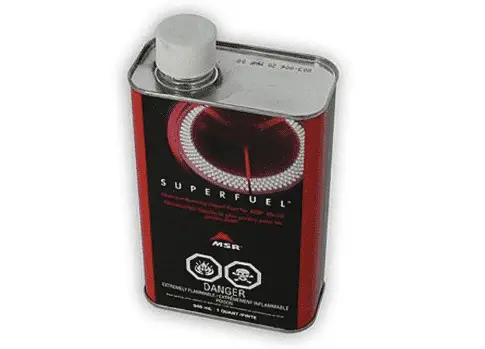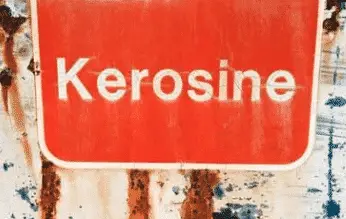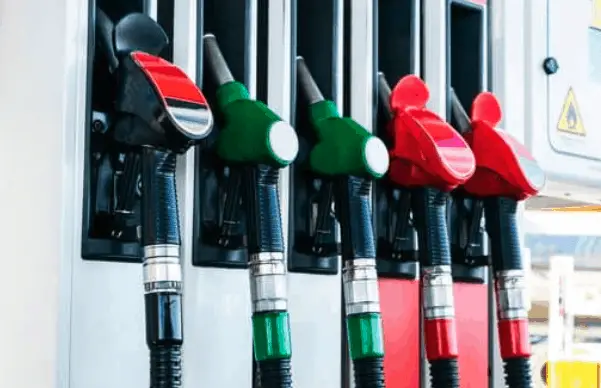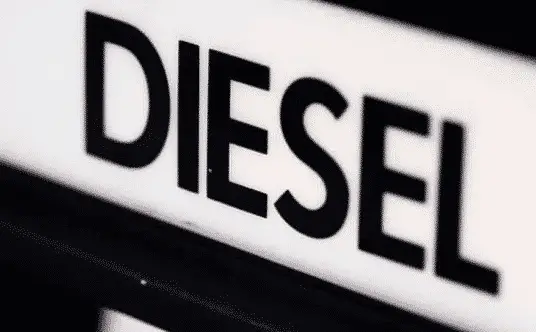Coleman fuel has been powering camp stoves for more years than I’ve been alive, but boy is it expensive. That’s why I decided to look into a few alternatives to Coleman Fuel.
Is there a better alternative to Coleman Fuel for camping stoves and lanterns? The main substitute to name brand Coleman Fuel is generic white gas. It’s basically the same thing minus a few of Coleman’s proprietary stabilizers and anti-corrosive additives. You can also use kerosene, diesel, gasoline and a few other fuel types, but it depends on your stove.
Just keep in mind that not every stove can work with all of these fuels. Keep reading below to figure out what kind of fuel is best for your camping or backpacking stove.
Table Of Contents
Cheaper Alternatives to Coleman Fuel
It’s seriously expensive compared to most other fuel types. At about $12 per gallon at my local Walmart, there are definitely cheaper options available. Look at how much a 32oz bottle of Coleman fuel costs on Amazon.
That 32oz container is really convenient on short camping trips, but boy is it expensive. You can save some cash by purchasing one of the following alternatives to Coleman Fuel. They will all burn, but some fuels are cleaner and more efficient than others.
- Generic White Gas: Generic white gas is by far the best substitute for name-brand Coleman fuel. It’s usually a few dollars cheaper and basically the same thing minus a few additives. It burns clean and there’s no risk of damaging your camping stove or lantern.
- Kerosine: Kerosine is the second-best alternative to Coleman fuel. It’s easy to find and way cheaper. The only downside is that it’s dirtier than white gas, but way cleaner than diesel and gasoline. If white gas isn’t easier to find kerosine is a great subsititute. Just plan on cleaning your stoves fuel lines frequently.
- Diesel: If you’re traveling in third world countries, diesel might be your only option. It burns dirty and smells, but it’s better than gasoline. You’ll have to clean out fuel lines, but it shouldn’t damage the stove.
- Gasoline: Gasoline isn’t great for your gear, but it’s cheap and easy to find. The additives used to increase engine performance will eat away at the fuel reservoir. It works well in a pinch, but shouldn’t be used long term.
- Other Fuel Types: All non-toxic flammable liquids can be used in a camping stove. Some are better than others, but as long as the fuel is easy to light it will work in a pinch. You probably won’t save any money burning biodiesel, paint thinner, etc.
What’s The Best Coleman Fuel Substitute?
When choosing a substitute for Coleman fuel you need to consider fuel price, ease of use and ongoing maintenance. Coleman fuel is seriously expensive compared to some of the other options. So what’s the best Coleman Fuel substitute?
White gas is by far the best option if you don’t want to pay for Coleman Fuel. It’s basically just an unbranded version without stabilizers and anti-corrosion additives. You can also use kerosene, diesel, and gasoline, but they will clog your stove.
Don’t look solely at the price when comparing fuel types. Just do yourself a favor and go with white gas if you can find it. It costs like $8 per gallon at my local Walmart. It’s just not worth the hassle of constantly cleaning your stove with dirty fuels.
Some Stoves Need Fast Burning Fuels!
You need to look at your stove before settling on an alternative fuel. It all depends on how the ignition system is setup. My Whisperlite International Backpacking Stove is designed to run on just about anything, but that’s rare.
Products like the old fashioned Coleman Stove can’t get hot enough to use hard to light fuels like kerosene or diesel. You would have to use a propane torch to heat up the preheater ignition coils, but that’s a serious pain in the butt.
Does Your Stove Run on Kerosene?
If your camping or backpacking stove runs on kerosene it should run on just about anything. This means that it has an extra hot preignition system and wider holes that won’t get clogged up on dirty fuels. They get hot enough to burn kerosene, diesel, white gas, gasoline, and every other fuel imaginable.
If your stove can’t run on kerosene you only have two options. You can choose between Coleman Fuel (aka White Gas or Naptha) or you can use gasoline. These are the only fuels that ignite at low temperatures.
International Stoves Are The Most Versatile
Look for stoves that are designed for international use. Premium fuels like white gas and Coleman fuel can be hard to get overseas. You’re basically stuck with gasoline, kerosene, diesel, or alcohol-based fuels.
So manufacturers have to improve the size of their fuel lines and increase the power of the ignition system to work on dirty and hard to burn fuels. An international model is definitely worth the slight price increase.
5 Coleman Fuel Substitutes
To make this list I considered the price, availability, ease of use, maintenance, and effect on your stove/lantern. Some products that work great initially will eventually clog/damage fuel lines and eat away at the stove.
Just because a fuel works in the short term doesn’t mean it won’t eventually damage the stove. For long term reliability of your camping stove you should always use white gas (Naptha) or Coleman Fuel.
When you’re in a bind some of the dirtier fuels are great alternatives, but they will damage your stove. Just clean the stove regularly and occasionally check/replace the fuel line.
1) White Gas (aka Naphtha): The Closest Substitute

White gas (aka Naptha) is by far the best alternative to Coleman Fuel. In the United States, it’s the generic name for Coleman Fuel without some of the additives. Overseas the products are usually exactly the same. Here are the differences between Coleman Fuel and White Gas.
It’s the purest form of gasoline that you can easily buy. It burns hot/clean regardless of the weather and lasts for a very long time. You won’t have to worry about the fuel gunking up your stove or the occasional rough start.
Priced at about $8 per gallon vs $12 (for Coleman Fuel) it’s just a cheaper maintenance-free alternative to the name-brand. The only real difference is Coleman puts anti-corrosion and stabilizers in their fuel.
These additives are great in theory, but not worth the added price. With that being said, I carry 2-3 small 32oz bottles of Coleman fuel in the trunk of my car just in case.
It’s hard to judge how much fuel you will need on longer trips. I’d much rather store a few small bottles in the trunk of my car just in case I need them. Remember that you won’t be able to pick up white gas at your local gas station. You will have to fill your stove up with regular gasoline which works, but damages the stove.
You could go with a bigger bottle, but the shelf life of white gas drops from 10 years to less than 1 once opened. I just kept ending up with half-filled gallons that weren’t large enough to take, but I couldn’t throw out.
They would just end up sitting on the shelf of my garage until they went bad. Check out my post explaining how long white gas lasts and how to store it long term.
Don’t confuse white gas with white spirit which is less pure and similar to kerosene. It will work, but it burns dirty and will eventually gunk up your stove.
2) Kerosene: Cheap, Clean, But Doesn’t Work in Every Stove

Sometimes you just can’t find white gas. The last time I traveled overseas it was almost impossible to find. You can’t bring it with you on a plane and shipping was ridiculously expensive.
So what else can you use? Your best bet will almost always be kerosene. It’s inexpensive and can be found just about anywhere, but it does have a few downsides. It’s dirty, smelly, and harder to light, but it works well once you figure it out.
Kerosene won’t cause permanent damage, but you will have to regularly clean your stove. It’s really dirty! You’ll have to clean and replace fuel lines to maintain an adequate fuel supply.
There’s just not enough regulation between different kerosene suppliers around the world. It all depends on who you’re buying it from and how it was stored.
Kerosene bought at a small market in a 3rd world country will be dirty. It burns dirty and clogs fuel lines fast. Figure out your stoves breakdown and maintenance procedures and plan on cleaning it faster than you think. You don’t want to end up stranded in the middle of nowhere without fuel.
Just keep in mind that not every camping/backpacking stove can burn kerosene. My MSR Whisperlite Backpacking stove can burn anything on this list, but my old Coleman stove cannot. The Coleman stove can only run on easy to light fuels like white gas and gasoline.
4) Gasoline (Easy to Light But Dirty)

I hate to say it, but gasoline is the last fuel you should use in a camping stove. Gasoline just contains too many additives, which are great for motors, but terrible for everything else.
It will quickly eat away at the plastic lines/seals in the pump and fuel line, and cause corrosion in the fuel reservoir. Plus the ethanol in the fuel will cause pitting and corrosion in the steel. Some of these issues can be avoided with regular cleaning and emptying your fuel bottles after use.
Whether or not that’s a big deal depends on how you feel about time and money. You’ll end up spending more time and money repairing the stove than you saved by not using Coleman Fuel or white gas.
I’m not going to lie and say that I’ve never used gasoline in my camping stove. Actually I end up using it multiple times per year. It’s just not worth running to a specialty store for white gas or Coleman Fuel. My vacation time is precious and I’m not going to bother running around searching for clean fuel when gas or diesel will work.
4) Diesel (Dirty- Use As a Last Resort)

Most people hate using diesel fuel in their stoves(some love it). I would only use diesel fuel in an emergency when I couldn’t find white gas, kerosene or gasoline. Diesel is just dirty, smelly, and hard to deal with(hope you like soot on your food). However, it will work in most stoves that can run on kerosene.
Why do I recommend diesel if it’s such a pain in the butt to use? Diesel fuel can be found anywhere in the world at consistent quality.
Unlike the other options on this list, it’s really hard to light and control. You’ll have to deal with flare-ups and problems in cold weather.
Just make sure that your stove can run on diesel fuel. Some of the smaller backpacking stoves will only run on white gas and kerosene. Diesel would probably work if you get it hot enough, but it voids the warranty and clogs the lines. So call up the manufacturer and ask if diesel or kerosene can be used with your stove.
5) Other Alternatives
There are lots of other fuels out there that could get you buy in a pinch. Any product that works like gasoline (racing fuel, aviation gas, jet fuel, etc) work like regular gasoline with/without additives. Products like mineral spirits, lacquer/paint thinner will all burn.
Just make sure that it’s safe to burn, odor-free, relatively clean and lights easily. It would be impossible to name all the different options and figure out if they could potentially damage the stove/lantern.
Other fuels that burn at low temperatures like biodiesel and plant oils probably won’t work. Some people decide to use them with mixed results. Personally, they are way too much hassle when you can buy cheaper and cleaner alternatives.
Bonus: Denatured Alcohol (Sometimes)
Go to any backpacking or camping blog and you’ll hear about alcohol powered stoves. Denatured alcohol stoves are lightweight and great for backpacking, but you need a special alcohol stove.
My Esbit Alcohol Stove runs on tiny alcohol bricks that you break apart(these things). You can also use liquid alcohol, but the tablets are so much lighter and easier to use. They’re really easy to light, smokeless, clean and residue-free.



